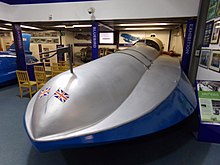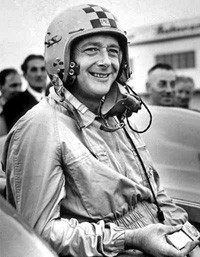
Donald Malcolm Campbell, was a British speed record breaker who broke eight absolute world speed records on water and on land in the 1950s and 1960s. He remains the only person to set both world land and water speed records in the same year (1964). He died during a water speed record attempt at Coniston Water in the Lake District, England.

Offshore powerboat racing is a type of racing by ocean-going powerboats, typically point-to-point racing.

Major Sir Malcolm Campbell was a British racing motorist and motoring journalist. He gained the world speed record on land and on water at various times, using vehicles called Blue Bird, including a 1921 Grand Prix Sunbeam. His son, Donald Campbell, carried on the family tradition by holding both land speed and water speed records.

Coniston Water is a lake in the Lake District in North West England. It is the third largest by volume, after Windermere and Ullswater, and the fifth-largest by area. The lake has a length of 8.7 kilometres, a maximum width of 730 metres (800 yd), and a maximum depth of 56.1 m. Its outflow is the River Crake, which drains into Morecambe Bay via the estuary of the River Leven. The lake is in the unitary authority of Westmorland and Furness, and the ceremonial county of Cumbria.
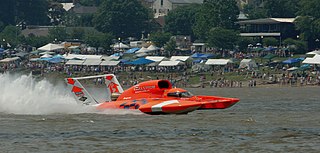
A hydroplane is a fast motorboat, where the hull shape is such that at speed, the weight of the boat is supported by planing forces, rather than simple buoyancy.

A motorboat or powerboat is a boat that is exclusively powered by an engine; faster examples may be called "speedboats".

The world unlimited water speed record is the officially recognised fastest speed achieved by a water-borne vehicle, irrespective of propulsion method. The current unlimited record is 511.11 km/h, achieved by Australian Ken Warby in the Spirit of Australia on 8 October 1978. Warby's record was still standing more than 45 years later.

The Rolls-Royce R is a British aero engine that was designed and built specifically for air racing purposes by Rolls-Royce Limited. Nineteen R engines were assembled in a limited production run between 1929 and 1931. Developed from the Rolls-Royce Buzzard, it was a 37-litre capacity, supercharged V-12 capable of producing just under 2,800 horsepower (2,090 kW), and weighed 1,640 pounds (770 kg). Intensive factory testing revealed mechanical failures which were remedied by redesigning the components, greatly improving reliability.

The Bluebird-Proteus CN7 is a gas turbine-powered vehicle that was driven by Donald Campbell and achieved the world land speed record on Lake Eyre in Australia on 17 July 1964. The vehicle set the FIA world record for the flying mile at 403.1 mph (648.7 km/h).
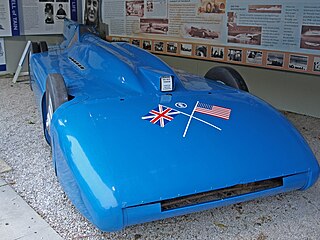
The Campbell-Railton Blue Bird was Sir Malcolm Campbell's final land speed record car.
Leopoldo Alfonso Villa was the long-serving mechanic of Sir Malcolm Campbell and Donald Campbell. He was born in London, of Italian and Scottish parents.
Bluebird of Chelsea, formerly Blue Bird, is a motor yacht originally built for Sir Malcolm Campbell.
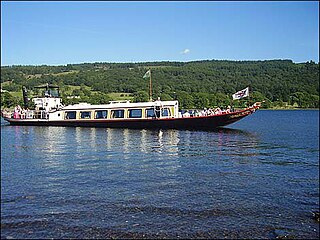
The steam yacht Gondola is a rebuilt Victorian, screw-propelled, steam-powered passenger vessel on Coniston Water, England. Originally launched in 1859, she was built for the steamer service carrying passengers from the Furness Railway and from the Coniston Railway. She was in commercial service until 1936 when she was retired, being converted to a houseboat in 1946. In 1979, by now derelict, she was given a new hull, engine, boiler and most of the superstructure. She is back in service as a passenger boat, still powered by steam and now operated by the National Trust.

Bluebird K7 is a jet engined hydroplane in which Britain's Donald Campbell set seven world water speed records between 1955 and 1967. K7 was the first successful jet-powered hydroplane, and was considered revolutionary when launched in January 1955. Campbell and K7 were responsible for adding almost 100 miles per hour (160 km/h) to the water speed record, taking it from existing mark of 178 miles per hour (286 km/h) to just over 276 miles per hour (444 km/h). Donald Campbell was killed in an accident with a much modified K7, on 4 January 1967, whilst making a bid for his eighth water speed record, with his aim to raise the record to over 300 miles per hour (480 km/h) on Coniston Water.
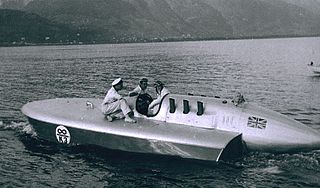
Blue Bird or Bluebird is the name of various cars and boats used by Sir Malcolm Campbell, his son Donald and other family members to set land and water speed records.
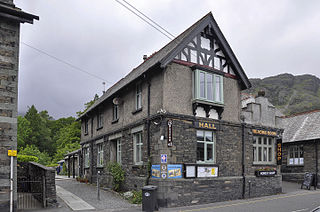
The Ruskin Museum is a small local museum in Coniston, Cumbria, northern England.

Mr Whoppit was the teddy bear mascot of Donald Campbell, the land and water speed record holder. Writing in his 2011 book, Donald Campbell: The Man Behind The Mask, journalist David Tremayne described Whoppit as Campbell's "magic talisman".

Blue Bird K3 is a hydroplane powerboat commissioned in 1937 by Sir Malcolm Campbell, to rival the Americans' efforts in the fight for the world water speed record. She set three world water speed records, first on Lake Maggiore in September 1937, then later twice raising her own record.
Peter Du Cane (1901–1984) was a Royal Navy commander and managing director of the engineering company Vospers. He assisted in the development of the Blue Bird II amongst other boats.

Stanley St. Claire Sayres was a hydroplane racer who broke the world water speed record with his "Slo-mo-shun IV" boat.


